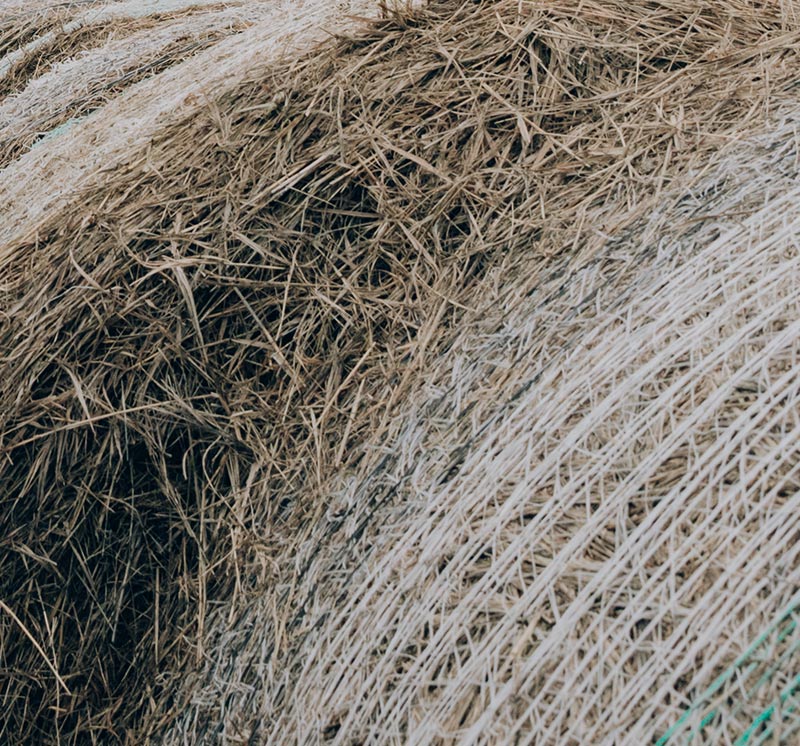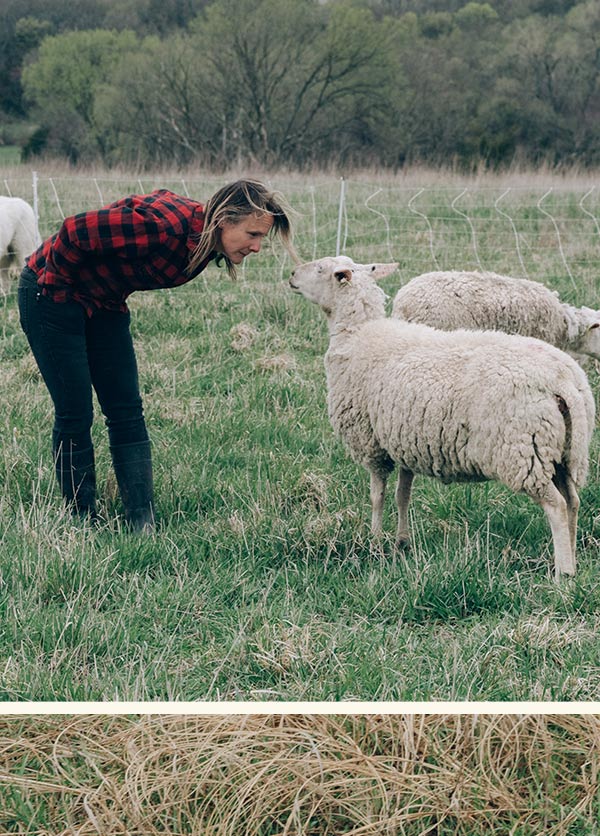

MEET A FARMER
JACQUELINE SMITH
Jacqueline Smith didn’t grow up farming. And she’s a woman. By some accounts, she has the deck stacked against her when it comes to starting a new farming business in the Midwest.
Not looking like or having the multi-generational agricultural background of a typical Midwest farmer presents challenges. But, as Smith will proudly tell you, they haven’t held her back. No, her biggest roadblock is one that faces all farmers — the sad economic state of rural America and the collapse of the family farm economy that once underpinned it.
It’s also what Smith is most passionate about changing.
Smith, 44, is making small but powerful steps toward regenerating the heartland of America. She is convinced that creating a regenerative-based, circular economy supporting farmers, soil health, natural environments and regional foodsheds is key to saving America’s heartland — its worn out commodity croplands, its dying rural communities and its desperate farmers.
Farmers can’t pursue better land management practices if they can’t pay their bills.
“We have asked our farmers to grow us food and live on poverty rate wages. So, farmers become enveloped in an idea of scarcity. It is fear-based and mind-numbing to work in the confinements of scarcity. You can’t make decisions there.” Smith says. “You can’t make decisions that protect the Earth there.”



The Quiet Collapse of the Heartland
As she entered young adulthood, Smith made an unusual decision compared to her high school classmates —most of them moved away after graduation. But not Smith. She would stake her claim and build her life in rural America, specifically the Midwest. As a farmer.
“I felt really called to my roots here and I knew that if I didn’t create that space for me, no one was going to create it,” Smith says. “So, I started to piece it together.”
That meant piecing together the strands of a “mid-tier,” decentralized supply chain infrastructure, supporting medium-sized farm business — a system that no longer exists.
The romantic version of the bustling, small-town, midwestern communities of the 1950s and 60s has largely been extinguished. The heartland economies and rural livelihoods of the early to mid 1900s died as agriculture became consolidated and the younger generations migrated to urban centers.
Farms themselves are still generally decentralized across America. Fifty-seven percent of the food grown in the U.S. is still produced on family farms, according to the 2016 report “Family Farms of North America.” But the support structure for agriculture — the infrastructure, supply chain and farm-based services — have become deeply consolidated.
In 2012, just four large firms controlled 57% of pesticide manufacturing and the four largest firms in farm machinery accounted for half of all sales. There simply no longer exist those “mom and pop” stores and businesses, providing services and supplies for farmers’ needs, creating jobs, and stimulating economies.

“They don’t have access to health care. They don’t have access to school. They don’t have access to water. This is a real thing. Their closest food outlet might be a Dollar General if they’re lucky.,” Smith says.
The slow-moving collapse of rural communities, the loss of agricultural diversity and opportunities and a prevailing sense of “scarcity” have made farming in the Midwest— especially farming with regeneration and environmental stewardship in mind — almost impossible.
“The level of scarcity that exists is not only financial, it is land scarcity, spiritual scarcity, community scarcity, opportunity scarcity. It is driving farming to have one of the highest suicide rates of any profession, especially in places like central and western Kansas, where there’s no opportunities and the inability to do anything about it.”
This is what Smith is driven to change.



Buying Lambs, Inspiring Regeneration
Her company, Central Grazing Company, sells regeneratively, humanely-raised lamb meat. Smith and partner ReGina Cruse raise lambs for the Central Grazing supply chain on their 80-acre farm in northeastern Kansas, managing 200 ewes with plans to scale up to 400.
They sell their lamb direct to consumers through a monthly box subscription and individual lamb cuts wholesale to businesses and chefs. They also are developing a line of naturally-dyed, handcrafted lambskin leather handbags, repurposing what had been an unusable byproduct – lamb leather. They plan to expand that side of their business with a branded line in 2022.
But where Smith makes her biggest contribution to regeneration is not by raising her own lambs but by buying them.
Central Grazing grew out of Smith’s first shepherding venture. With no prior experience raising sheep, she co-founded and ran a successful sheep dairy in Missouri, managing 600 ewes on 125 acres and producing handcrafted cheeses that sold nationally.
“It makes me giggle now,” Smith says, looking back on the sheep dairy venture. “Because that’s incredibly hard work.” Yet it was hard work that was revitalizing for the Missouri farming economy and would eventually lead to Central Grazing.
The sheep dairy operation was so successful they outgrew their supply and needed more sheep milk. So, Smith and her business partner found more farmers interested in dairy sheep and taught them everything they had learned. Then they bought their milk.
When they started, they were the first and only sheep dairy in Missouri. By the time Smith left to start Central Grazing, there were 12 sheep dairies in Missouri and a new opportunity.
In 2015 Smith sold her interest in the sheep dairy and formed her Central Grazing. She started raising her own lambs for their direct-to-consumer sales and buying more market lambs from farmers in Missouri, Kansas, Oklahoma and Iowa, keeping those animals out of the feedlot system and helping fellow farmers regenerate their farm practices by encouraging animal production.
That first year Central Grazing sold 75 lambs. In 2020, despite the pandemic, they sold 2000 with demand for more.
Changing the Big Meat System
Smith raises and harvests lamb for their meat and leather products, a farming path many compassionate consumers find objectionable. Smith completely understands, she felt the same way for many years.
Always profoundly empathetic toward animals, Smith was vegetarian for more than a decade as a teen and young adult and refused to wear leather products. Not supporting animal production by refusing to eat meat was the only way she knew, at the time, to change the system.
But as she began farming for herself and pursuing regenerative practices, Smith realized she held the power to change the system she couldn’t support. Not by opting out of animal-based production — a critical missing link crippling the economic and soil health of the Midwest farming community — but by controlling how her sheep are raised and harvested. Then, encouraging other farmers to do the same thing.
Central Grazing is “Animal Welfare Approved” by A Greener World (AGW), a United States Department of Agriculture (USDA) approved, third party certifier that audits and supports independent farmers. The animal welfare approved label is the only U.S. label guaranteeing animals are raised outdoors on pasture or range for their entire lives and that farms use sustainable, high-welfare practices.
At Central Grazing they think about the welfare of their sheep from “the time that they’re born until the time that they are slaughtered for food,” Smith says.



They carefully consider small details like, how their fences are designed and how far the loading dock is from the edge of the trailer when they transport their lambs to slaughter. They only partner with small, regional slaughter facilities that meet their standards of humane harvesting protocols and purchase lambs from fellow farmers that meet similar standards of animal welfare.
“It’s sad when my animals go to market. It’s a sad business. But it’s necessary. And I have been blessed with the care of it,” Smith explains.
On-farm animal production, managed with care and respect of animals’ lives and the soil and land they are grazed upon, is a necessary part of the regenerative cycle, Smith says. When animals are removed from a diverse farm production system, an ecosystem becomes unbalanced, much like it has for most Midwest farmers, trapped in the soy/corn commodity crop rotation cycle. Big meat production, CAFO’s and the commodity slaughterhouses that Smith can’t stomach are the result of that same imbalanced system.
People that opt out of eating meat do help to rebalance the commodity meat system, Smith says. But so do those who choose to support farmers that humanely raise animals for their meat and other products.
“People who decide not to eat meat help change the system. But we also need those people who know how to eat meat the right way and find meat the right way,” Smith says. “We need those people too.”
Smaller-scale animal production supporting regional food systems encourages the humane treatment of animals. And it is critical to healthy, regenerative ecosystems, Smith says.
“When we look at nature, as the mother that supports all of our lives, we realize nature consumes itself. Everything lives and everything dies. The Earth needs all of the players in the ecosystem to regenerate itself.”
The Earth needs regeneratively-grazed management systems.
It’s a slow healing process, it takes some time and you have to be patient.
What Is Regenerative Grazing and How Can it Help Midwest Farmers?
Regenerative grazing is a suite of techniques that integrate livestock — primarily ruminants like cattle, sheep and goats — into managed grazing systems. Sometimes called managed intensive grazing, or adaptive multi-paddock grazing, animals are bunched together in groups and moved often, encouraging them to graze lightly, leave behind their fertile manure and trample grasses into the soil, all beneficial for improving soil health.
On Smith’s farm, they move their ewes every 24 hours to a new paddock, following a carefully mapped out plan. As needed, they seed their pastures with cover crops and legumes to encourage a more diverse species mix that supports the sheep’s nutritional needs.
The Central Grazing property was heavily tilled before being turned into hayfields and by the time Smith and Cruse moved onto it, the soil was tired and worn out. They don’t expect overnight results, but they know it will get there and take yearly soil tests to monitor their progress.
Not only does regenerative grazing heal soil, but it also improves water infiltration, leading to better water retention and drought resilience, as the Pasture Project reveals in a story map report on regenerative grazing. Regenerative grazing techniques reduce phosphorus pollution in waterways. Transitioning row crop production like soy and corn to pasture-based grassland systems can reduce nutrient pollution by up to 97%.
All this, while returning higher profits to farmers and stimulating the revival of what once was — a vibrant, agrarian-based Midwest economy.
Improved farm financial resilience has implications for the overall health of rural communities.
“Younger generations may have more entry points and opportunities to grow their own farm businesses. More families and family members remaining on the land strengthen the social and economic fabric of rural communities; they fill schools, patronize grocery stores, populate first responder units, and participate in their communities, according to a report published in the January 2021 Journal of Soil and Water Conservation.

Exactly the circular, regionally-driven, regenerative farm-based system Smith dreams of.
Not Your Stereotypical Midwest Farmer
As a woman in a largely male-dominated sector, especially a woman that didn’t know how to “grease tractors or write business plans,” earning the respect of her colleagues has been hard, Smith says.
Sixty-two percent of U.S. farm operators are men, the average age of 59.4, although women-run farms have been gaining ground, according to United States Department of Agriculture (USDA) statistics.
Regardless, it is clear that most American farmers don’t look or have the background Smith does. In an agricultural commodity system that largely favors large, farming enterprises, what Smith has accomplished hasn’t been easy .
That’s because she has refused to let anything hold back her dreams. Smith deals with the hurdles in her way by keeping her eye on the prize. Whether it’s peers that dismiss her or conventional farmers that don’t believe in regenerative practices, if the conversation can’t come to the point of agreement, she’s not interested in having it, she says.
Smith’s looking for solutions. She doesn’t have time for anything else.
“I walk away from those conversations. They don’t take up space in my life,” Smith says. “I focus on the partners that are in this with me.”
And, Smith says, she is proud to say she’s done it. “I can hold my place and I have built a respectable business.”
Not that there isn’t plenty more to be done.
We’re able to keep moving forward, even during COVID. It’s working.
The Daily Life of an Agricultural Entrepreneur
They prepare the paddocks to rotate into. They take their portable, electrified fence down and put it back up. They hook up the solar powered boxes and bring the sheep water and minerals. They make sure their four livestock guardian dogs Rex, Tru, Merry and Blu — their job is to live with the flock and protect them from predators — are settled in and have their food.
For Smith, however, that’s just a small part of her daily chores. She is the “CEO of an early-stage company” and that means her day is structured much like any other entrepreneur building their business. Just with a farm to boot.
“I have to wear multiple hats,” Smith explains. “From running the fulfillment line in the warehouse, to interacting with investors, to telling your story to journalists, to moving the sheep.”
She spends a lot of her time these days working to find new investment pathways for small and midsize farmers that support her vision of regeneration and rebuilding mid-tier supply chains.
We look to farmers to manage the land and grow healthy food that sustains us all, yet force them to take on all the financial risk of doing so, Smith points out.
Smith looks at the billions of dollars in investment money being put toward tech start-up businesses in food and farming, and asks a question most don’t ever think about. Shouldn’t investors that care about the planet be investing in regenerating farmers and the land they steward, too? Why are environmental, societal and governance (ESG) investors putting money into concepts that claim to be environmentally friendly, rather than investing in the farmers that are doing the work and land they hope to regenerate?
How do we create the (money) vehicles that work for farmers?


For Smith, all of this boils down to a recognized commitment across every level — governmental, non-profits, consumers, investors — toward supporting more farmers and giving them more opportunities to choose to regenerate land and livelihoods. That’s the path she sees for pushing forward and rebuilding the economic structure of the rural, agricultural communities she loves.
Besides her work at Central Grazing, Smith mentors young and upcoming farmers and connects with a growing contingency of like-minded individuals. Smith is on the advisory board of Great Plains Regeneration, a recently formed non-profit supporting regional, regenerative food systems. Collaboration is key.
“What my work is doing, it’s a tiny little piece of the puzzle. I’m working with my brothers and sisters in this to unite our work together and change the system,” Smith says.
Of course, changing the system isn’t an easy goal. Indeed it’s a pretty big one that can seem overwhelming, at times. That’s when she takes a deep breath, refocuses and pushes again.
Then again, Smith has never been one to back down from pursuing her dreams. After all, how many young women tell their parents their life dream is to become a shepherd, then actually go out and do it?
“My parents didn’t know what to do with me,” Smith says, laughing as she recalls that fateful conversation. “They had no idea. So, they said, ‘that’s good. And here I am 23 years later, still a shepherdess.”
A shepherdess. And so much more.
Visual art, video and photography by Leia Marasovich.

Support
Jacqueline Smith
& Her Efforts:
Contact:
